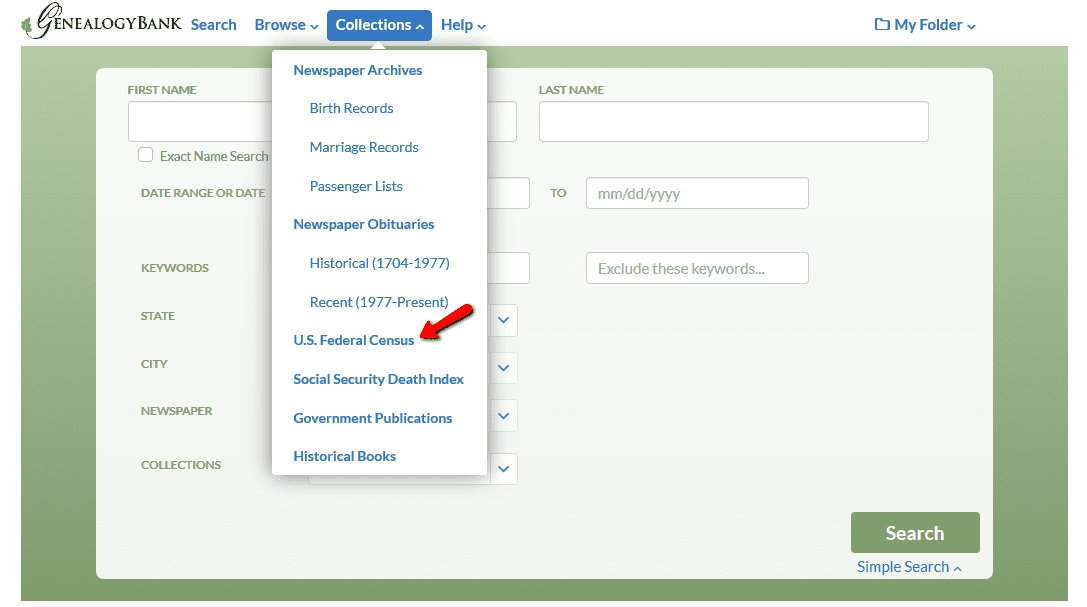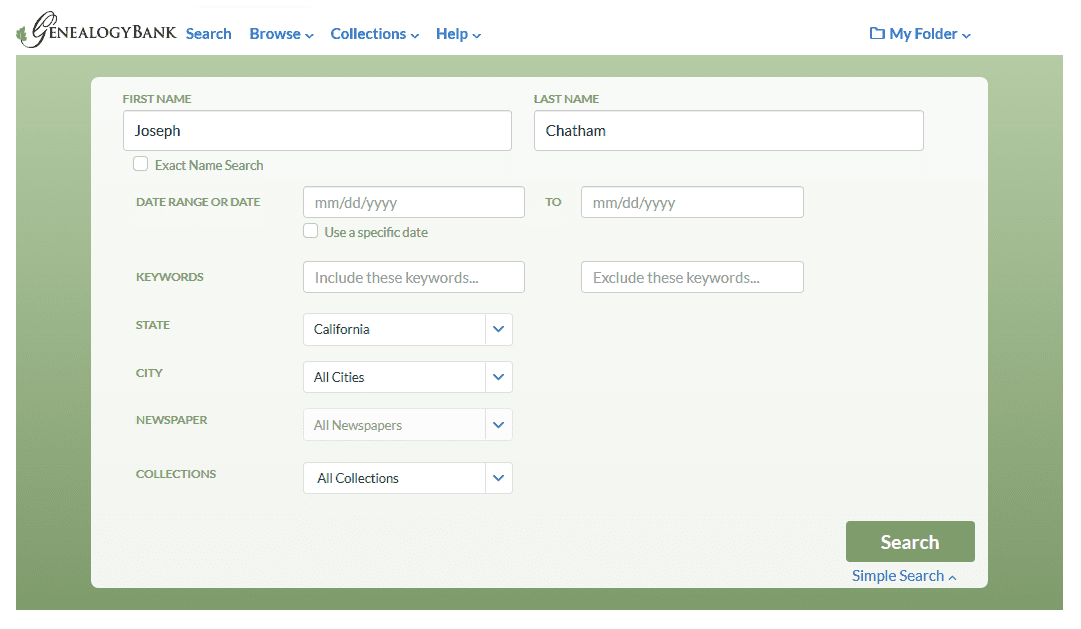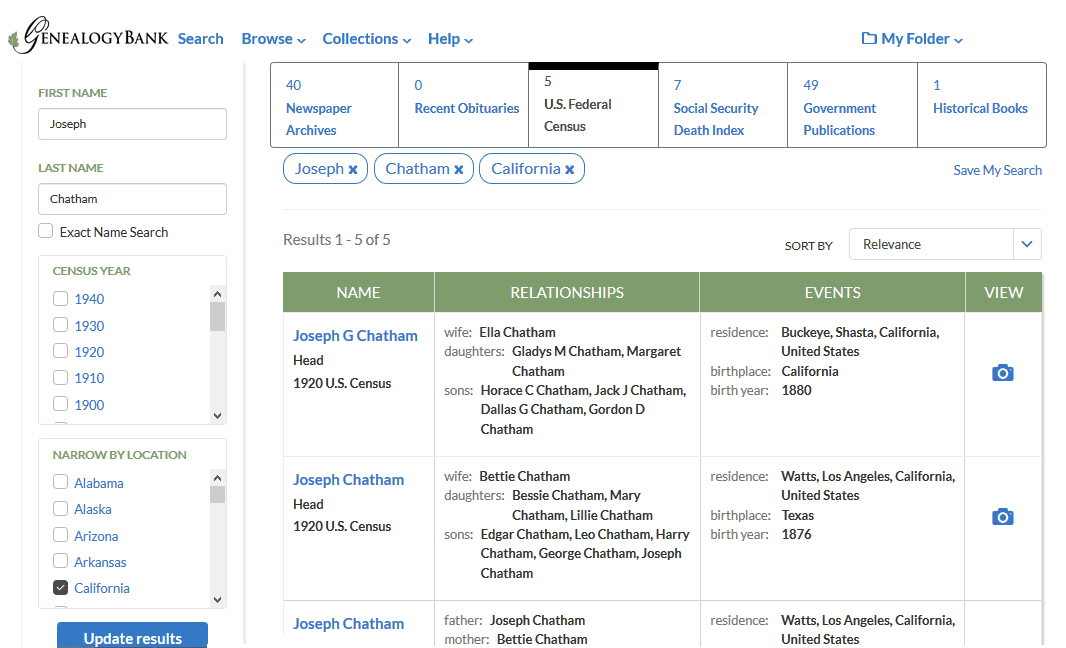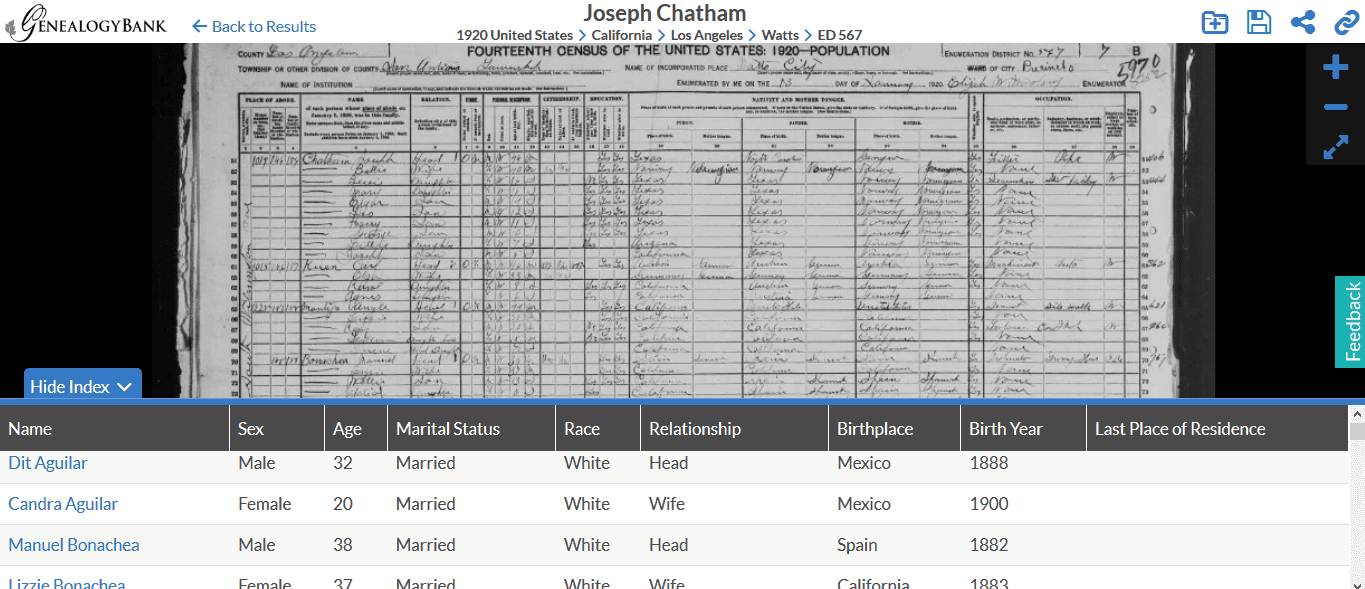Introduction: In this article, Gena Philibert-Ortega writes about the new feature added to GenealogyBank: the U.S. Federal Census. Gena is a genealogist and author of the book “From the Family Kitchen.”
Did you notice? GenealogyBank doesn’t just have a great newspaper collection, government publications, historical books, and the Social Security Death Index – it now has the U.S. Federal Census! Thanks to a partnership with FamilySearch, you can now search the U.S. Federal Census population schedules from 1790-1940 on the GenealogyBank website.* Here is what you need to know to start searching the census for your ancestors.
There are a few different ways you can search the census on GenealogyBank. You can do a search from the GenealogyBank homepage that will look at all the site’s content, including the census; you can also specifically search just the census by clicking on “Collections” at the top of the GenealogyBank homepage and choosing “U.S. Federal Census” from the drop-down menu.

Beginning with a General Search
In this example, I will do a search in all of GenealogyBank’s collections at once by using the general search box on GenealogyBank’s home page.
Start your search by typing in an ancestor’s name. You may also want to choose a state, if you know where you ancestor lived. In this example I’m searching on my ancestor Joseph Chatham, who lived in California.

Search Results Page
The general search for Joseph Chatham in California gave me this search results page.

Notice that the top of the search results page breaks down the hits by category: 40 newspaper articles (the default results shown); 5 hits on the U.S. Federal Census; 7 records in the Social Security Death Index; 49 results in the Government Publications collection; and 1 mention in a Historical Book. This menu on the top of the search results page gives you another way to access the U.S. Federal Census.
Since we’re focusing on the census in this article, let’s click on the “U.S. Federal Census” menu choice, giving us this census search results page.

I can use this four-column results list to determine what census documents I want to look at. The first column, NAME, provides me the name, relationship to the head of household, and the census year. The second column, RELATIONSHIPS, lists the names of those who were enumerated at the same address, along with their relationships to the head of the household. The third column, EVENTS, provides the residence, birthplace and birth year of the person named in column 1. The fourth column has a camera icon which you can click on to see the actual image.
What do you do if your census search results page has too many results? There are search engine options on the left-hand side of the screen that allow you to either conduct a new search or narrow your current search. This is an important tool when researching a common name. You can use these tools to focus on one census year, a specific state, or even make changes to the name you searched. Notice that you are also given the option under the last name box to conduct an exact name search.
Just like your newspaper search results page on GenealogyBank, you can show your census results by sorting by Oldest First, Newest First, or Relevance. The “Sort by” option is found at the top right-hand side of your results. This sorting option can be helpful if you are searching more than one census year.
Before we look more closely at the census, let me just remind you that you can use the “Save My Search” link on the search results page. This allows you to save each search you do on GenealogyBank into your Folder. You can click on “My Folder” at any time to see your previous searches or items you saved.
Looking at a Census Page
Looking at my census search results page, I see that the second result listed is my ancestor in the 1920 census. I want to click on the camera icon so that I can view the 1920 U.S. Federal Census page that includes my ancestor, Joseph Chatham.

There are seven tools in the upper right-hand corner of this page that can assist you.

The four tools at the very top of the screen allow you to:
- Save to My Folder: this allows you to save your finds in GenealogyBank
- Save to My Computer: this allows you to save the census page to your computer
- Share Your Find: share with up to 10 email addresses
- Copy the Link: copy the census link to your computer’s Clipboard
The three tools on the right-hand edge change the way you view the census page:
- The Plus Sign: allows you to zoom in on the page
- The Minus Sign: allows you to zoom out on the page
- The Diagonal Sign: allows you to view the page in full-screen mode
Now look toward the bottom of the census page. You’ll notice in the bottom left-hand corner are the words “Show Index” in blue. Click on this to reveal an index listing of the people enumerated on that census page.

This index provides transcribed name, sex, age, marital status, race, relationship, birthplace, birth year, and last place of residence (applicable for the 1940 U.S. Census only) for everyone listed on that page.
This index can make reading a census page easier, but remember that there can be transcription errors – so always look at the original document for confirmation. To collapse the Index, just click on “Hide Index” blue button.
Who Will You Find?
The census in GenealogyBank provides you the ability to combine your newspaper searches with the census. This saves you time and makes it easy to locate names in the census that you find in the newspaper. This addition to GenealogyBank makes finding your ancestors and telling their story easier than ever before!
* Although the U.S. Federal Census collection includes the 1890 census, remember that the 1890 Federal Census was largely destroyed by a fire in 1921.
Related Articles:

Wow! This is a remarkable feature. Every genealogist can benefit from this additional resource on your website. Thanks a bunch.
You’re very welcome, Alice; the response has been very positive!
Is there any place to correct a name which was not spelled correctly in the census page? I am delighted that you now have access to the Census Records – I worked on those through FamilySearch a number of years ago and hope to get back to it – I found it fascinating to bring family members together in that way.
Elaine,
This all depends on whether or not the error is on the indexed portion (what’s typed out at the bottom of the page) or in the census record itself. For the former, yes, those indexed names may have their spellings corrected. What may be problematic, though, is just the nature of census enumerators’ misspellings.
“Some researchers become concerned about incorrect information in census records, even to the point of not believing it’s their ancestor because one piece of information is incorrect. Even though the surname was misspelled it doesn’t mean it’s not my grandpa. Researchers need to remember that records are created by people and people make mistakes. Errors are going to creep into records. We need to properly analyze all of the information to determine if the information matches that of our ancestors.
“We also need to remember that the census was not created for genealogists. They are a serendipitous genealogical result of the government’s program to account for the U.S. population. Census takers may have thought the records would never be seen again, resulting in less than accurate recording. Thus, strange or obviously incorrect information is riddled throughout the census records.” (Quote taken from site visited on Feb. 19, 1019– https://www.familysearch.org/blog/en/census-taker-wrong/)
That said, if you do run into something that has been indexed incorrectly, contact whoever posted that Census and its index. In this case, it would be FamilySearch.org. They will then be able to help correct any errors in spelling, where possible.
I am very pleased and looking forward to trying this new feature. It looks like this will be an amazing tool in searching for my ancestors!
Good luck with your searches, Brenda!
Thanks for this information.
Thanks, Hilda. We hope the census records help you find more information about your ancestors!
I really like your instructions for using this tool. It makes the search process much easier and faster to have guidance with how to use the information to our best advantage. Good job, Gena and GenealogyBank!
Thanks Bernice! I appreciate that and that you took the time to comment. Happy census searching!